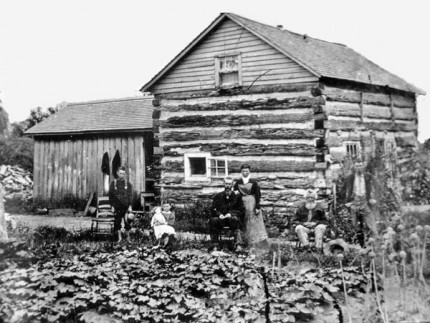
(Chelsea Update would like to thank Tom Hodgson and the Waterloo Natural History Association for the photos and information in this column.)
The topography of the Waterloo Area and surroundings was formed by the convergence of three large lobes of the last glacier some 10,000 years ago.
One lobe approached from east (the Erie lobe) one from the northeast, (the Saginaw Lobe) and one from the northwest. Waterloo was trapped in the middle as an inter-lobate area. Water and glacial debris poured from these melting ice lobes and settled over the land creating rugged hills, many kettle lakes, extensive lowlands and marshes.
Fluted projectile points found in the area tell us that Waterloo was soon occupied by ancient peoples who killed pre-historic elephant-like giant mastodons. Mastodon teeth and other skeletal remains have been unearthed by local farmers.
Gradually, these ancient peoples were replaced by modern tribes. The predominant tribes were of the Algonquin language group, the most prominent being the Potawatomi, Chippewa, Ottawa and Sauk. The Wyandotte of the Iroquoian language group were also present for a short time.
The Waterloo area was commonly used as hunting grounds by the Algonquin, and other than a few foot trails, Native Americans made no notable changes to the landscape. Their villages were no more than temporary hunting camps.
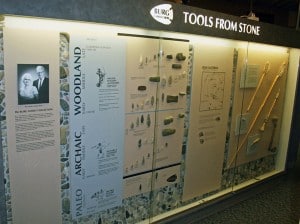
The only evidence of their presence were the stone tools that they left behind including knives, spear points, arrow heads, axes, scrapers and grinding tools. Thanks to the interest of Chelsea pharmacist J. Vincent Burg over 2,000 native artifacts were collected and are now on display at the Discovery Center. (That’s an interesting story in itself, which I’ll save for another article.)
French and Canadian fur trappers preceded settlers, and also left the area as they found it. A Frenchman named Jean Baptiste established a trading post in Jackson County in 1816, and he married the daughter of a Potawatomi chief.
With the arrival of settlers, the forests were cleared and the swamps were drained, lowering the surface waters as much as 6 feet. The struggles and hardships of pioneering are well known. Among the crucial times weathered by the Waterloo settlers was the cold winter of 1834 when cattle and livestock died and deer were found frozen to death in the woods. In the summer of the same year, the dry grass and leaves caught fire threatening many cabins and buildings.
Farmers were attracted to Waterloo because of the higher quality of alluvial soil and dependable water supply. The average farm had a cow, sheep, a few pigs and chickens, with horses and oxen for work animals. Corn, rye, wheat and buckwheat were the main crops, while vegetable gardens provided fresh or canned vegetables all year. Some farmers even had ice houses for preserving meat.
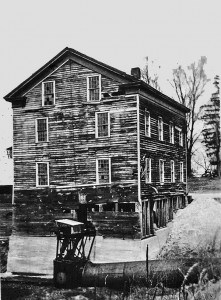
With land selling for $1.25 per acre in 1835-1836, many homesteaders and speculators from the east purchased land from the government, Patrick Hubbard was one of them. The village formerly known as East Portage was renamed Waterloo by Hubbard and his wife, Lydia, who came from Waterloo, New York. (An 1847 legislative act gave the township the name Waterloo).
Patrick Hubbard built the first sawmill in the area, and later a grist mill and frame schoolhouse. John Farnsworth was hired to survey and plat the village in 1836, and a United States Post Office opened for business in 1836. The township was “approved” on March 23, 1836.
Immigrants were predominantly Irish and German, with the Catholics residing in the east and southeast and Germans in the west and southwest. People of other nationalities included Scottish, English and French, settling for the most part in the north and northeast. Other towns were also established in the area including Trist (originally called Calf Town), Grass Lake, Chelsea, Munith and Stockbridge.
With most area roads still little more than two-tracks, the railroad was vital for transporting goods produced by local farmers and for bringing in supplies. Those towns that were fortunate enough to be located along a railroad line continued to prosper and grow. Those that were not, were reduced to a collection of houses and buildings, a sad reminder of what they once had been.
The Great Depression was a tipping point that brought many changes to the area.
Next week’s article will cover the role this historic period played in the creation and development of the Waterloo Recreation Area.








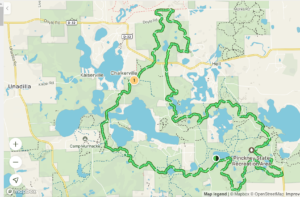

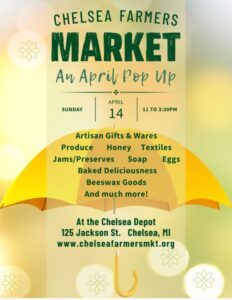
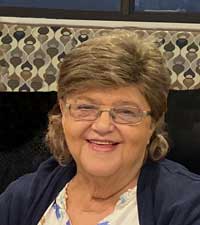


very interesting stuff. thanks.
We certainly have an ecological treasure in the Waterloo Pinckney Recreation area. I’m glad it has been protected for all of us.
Thank you. I ride the equestrian trails in Waterloo recreation. Our horseman association has adopted the horseman’s camp on Loveland rd. It’s great to see history on the land and trails we love so much. I also live off of Race rd. And have to drive though the Portage section on a daily basis. Looking forward to your next article about the Recreation Area.
Thank you for this article. I have lived on Waterloo Road nearly my entire life and my father and his father before him lived near my present home. I did not know the history of this area and this information was very interesting to me. I will pass this on to my children.
This is a great article. This area is a big part of the Klink family history. For years the Mill Pond area had the unofficial title of Klinkville and many of the residents were Klinks.
I am looking for more information about the town of Trust (or Calf Town). Any input would be appreciated.
Thanks again!
Thank you for this series. It’s a pleasure reading the history out here. I’ve found some Indian artifacts on our property on the Winnewana Impountment and enjoyed seeing the collection at the Discovery Center.